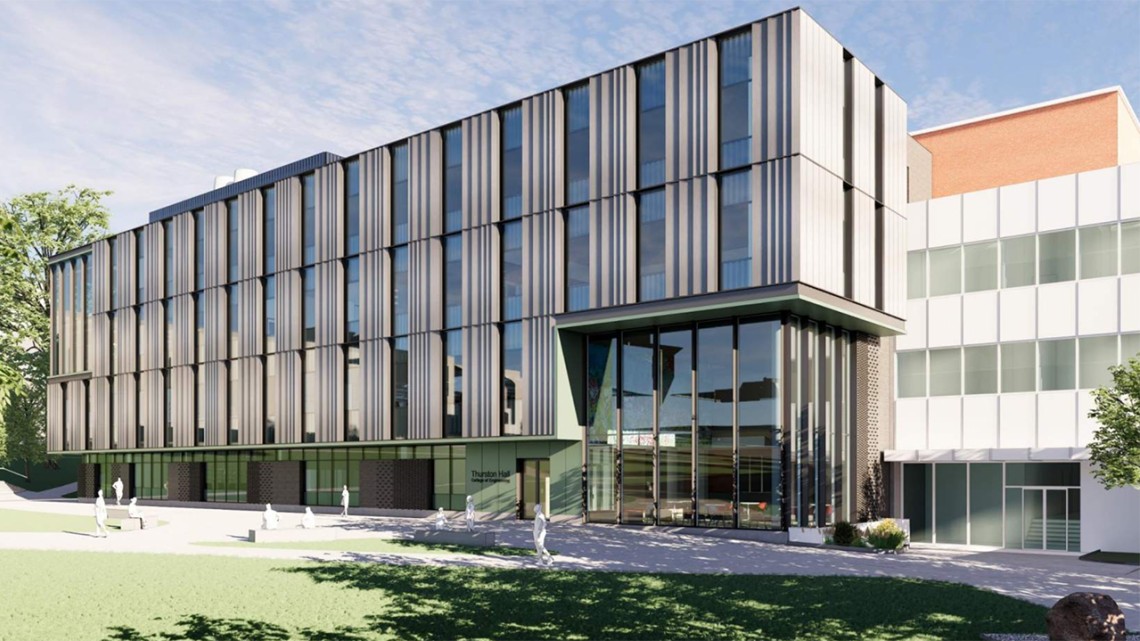
A rendering of the Thurston Hall expansion.
Thurston Hall addition to modernize the Engineering Quad
By Syl Kacapyr
A $40 million building project will expand Thurston Hall, providing laboratory, teaching and meeting spaces for multiple engineering departments while giving the south end of the Engineering Quad a modern new look.
Early site preparation and other enabling work is now underway for the four-story addition that will add about 30,000 net square feet to Thurston Hall and transform its stone and brick façade, originally built in 1951, into a contemporary glass and metallic exterior. Construction is scheduled to begin in January 2023 and last through summer 2024.
“Seventy-five years ago, engineers focused on building things that were very big and often mechanical,” said Lynden Archer, the Joseph Silbert Dean of Engineering. “Now we require facilities that enable new modes of teaching and research of phenomena at small length scales, such as examining the biomolecular processes responsible for diseases like cancer, Alzheimer’s and heart disease.”
The addition will give the Nancy E. and Peter C. Meinig School of Biomedical Engineering a visible presence at the center of the Engineering Quad. One of Cornell Engineering’s fastest-growing academic programs, the school has outgrown the space available in its primary location, Weill Hall, about half a mile away.
“As our enrollment increases, we have many more classes and students,” said Marjolein van der Meulen, the Swanson Professor and the James M. and Marsha McCormick Director of Biomedical Engineering. “The Thurston Hall addition is a really outstanding solution and puts us squarely in the middle of the engineering community, which I think is really important for our undergraduate students.”
The addition will also add to the footprint of the Department of Materials Science and Engineering, which has also outgrown its allocated spaces in Thurston Hall and the adjoining Bard Hall. Four materials science research groups will occupy labs on the fourth floor, including groups led by two new faculty members. And, with teaching laboratories neighboring each other on the second and third floors, materials scientists and biomedical engineers will have unprecedented opportunity to forge new collaborations, said Lara Estroff, director of the Department of Materials Science and Engineering.
“For any material that is going into the body, whether it’s a stent, bone graft or contact lenses, you need to know both the biology and the materials science,” Estroff said. “Having this space in which our undergrads and masters students overlap and get to interact with each other is going to lead to a lot of exciting opportunities.”
Each floor of the addition will host open collaboration spaces, a feature that is lacking in the existing complex. The first floor will include a lobby that serves as the building’s main community space, with the rest of the floor dedicated to experiential learning, such as student design studios and learning labs.
Designed by architecture firm NBBJ’s Boston studio, the energy-efficient addition – minimally achieving LEED silver – is being funded by Cornell Engineering with crucial support from alumni and friends of the college. The project advances a key component of the college’s strategic plan to modernize its spaces, building-by-building.
“In a very central, very prominent site within the engineering quad, people will come into that building and be part of the culture of that community of engineers,” said Margaret Carney, B.Arch. ’81, university architect. “You’ll be able to look into the teaching labs on the first floor, and the students in those labs will have windows out to the quad. To be able to activate the quad by having that presence of students is really going to be a game changer.”
Syl Kacapyr is associate director of marketing and communications for the College of Engineering.
Get Cornell news delivered right to your inbox.
Subscribe
